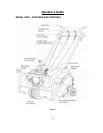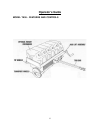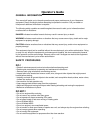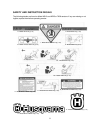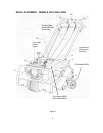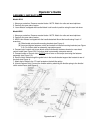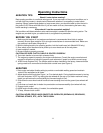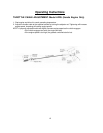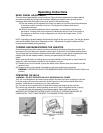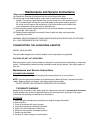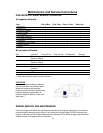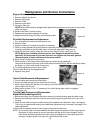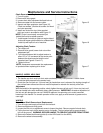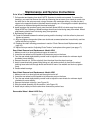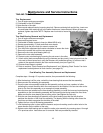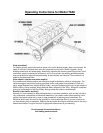
13
REAR WHEEL ADJUSTMENT
The rear wheel depth/stability control knob (see Figure 6) allows adjustment for better stability
and maneuverability by turning knob clockwise. Adjusting for depth by turning knob counter
clockwise determines the length of the cores pulled in the following ways:
(A)The rear wheels can be adjusted to the level you desire so you can control the penetration
of the tines to within a fraction of an inch. The length of the cores pulled can be
controlled accordingly.
(B) With the rear wheels adjusted to the full up position, you will obtain maximum tine
penetration. Pushing down on the machine’s handle bars will put most of the weight of
the machine on the tines. In this configuration you will pull the longest cores. (Front
wheel will rise).
NOTE: Adjusting for greater stability will shorten the length of the cores you pull. You will gain greater
side-to-side stability (see below “Operating on Hills.” Adjustments for greater stability will also
improve maneuverability during aeration.)
TURNING AND MANEUVERING THE AERATOR
Gradual maneuvering while aerating can be accomplished by simply guiding the machine. We
recommend that you adjust your engine’s speed control to allow for a comfortable walking speed.
This will also help you maintain complete control while working in tight spaces. Adjusting for more
stability (with the rear wheels lowered, reducing tine penetration) will make turning
easier.
When reversing direction or making sharp turns two methods of turning can be used. Select the
safest and most comfortable method for the conditions you face:
(A) Release clutch control handle, pull up rear wheel control handle, then pivot machine on rear
wheels to turn.
(B) Release clutch control handle, lift handle bar and pivot machine on front wheel.
WARNING: THIS METHOD IS NOT RECOMMENDED WHEN OPERATING ON HILLS (See next
section).
OPERATING ON HILLS
WARNING - DO NOT OPERATE ON HILLS EXCEEDING 35% GRADE.
This unit is not designed to be used on steep slopes. Be aware that when operating on hills the
tilt of the aerator will cause the machine’s center of gravity to shift to the downhill side of the
machine. Under these circumstances you may experience:
(A) The need to exert a greater effort to steer and maintain the balance of the machine.
(B) Uneven tine penetration, when operating across a hill. Due to the shifted center of gravity
the downhill tines will penetrate to the maximum depth, while uphill tines may not.
WARNING: IN EXTREME SITUATIONS (VERY STEEP HILLS) THE MACHINE MAY BE SO
UNBALANCED, THAT IT MAY PRESENT THE DANGER OF ROLLING OVER.
Figure 7
Figure 8
Figure 6
Operating Instructions



